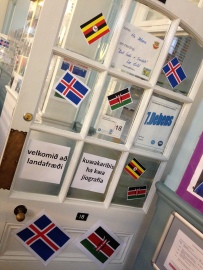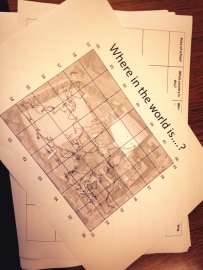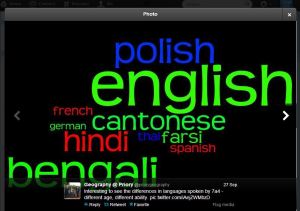
So Thursday was the European Day of Languages and I wanted to make sure that Geography supported the events going on in school. The MFL department had been busy making and displaying different flags and bits of information about other countries around the school, every department was meant to be meeting and greeting kids with a chosen language for the day, and we even had a more varied multicultural menu in the dining room for the day which was delicious. Naturally this is all geography really, so we needed to get involved.
I decided to draw on the work of Sam Atkins, and the work he produced last year for the mobile@priory project with his upside down map of the world linking to a lesson with EAL (English as Additional Language) – this project can be seen on the mobile@priory ‘cookbook’ here. The lesson slideshow for this week is below:
This is how I ran the lesson, the others may have done differently.
Slide 1) students were greeted at the door with the Icelandic for ‘welcome to Geography’ and had to guess what the phrase meant
Slide 2) I took a suggestions poll for how many languages the students thought were spoken at Priory. The answer is over 37. We then had a quick discussion about their surprise at this, and that 300 languages are spoken in London. Then students discussed in table groups how many languages they could speak fluently or conversationally, and which languages these were. I asked them to decide if there were any patterns to where these languages came from, i.e. are they from a predominant continent / group of countries, from a similar cultural background, etc,. Geography is all about people in the world, and about patterns, so we really hyped this up.
Slide 3) Priory is a Rights Respecting School, with the Level 1 award and working towards Level 2. We routinely link to the Unicef charter in lesson and it’s part of everyday conversation in school, so this came as no surprise to the kids. Article 30 states that each has the right to ‘use your own language’ – so we had a quick chat about this and what it means, linking to responsibility for attempting to learn other languages in order to make communications easier (they were well aware of reputation the English have; the classic example of going abroad and then assuming everyone will speak English and if they don’t we just speak louder English and use gestures!).
 Slide 4) The main part of the lesson using the upside down map of the world superimposed over the school site map. I introduced students who hadn’t seen it before (I ran this lesson with year 7-9) and explained how to worked, we did some simple orientation exercises and practised some grid refs to acquaint them.
Slide 4) The main part of the lesson using the upside down map of the world superimposed over the school site map. I introduced students who hadn’t seen it before (I ran this lesson with year 7-9) and explained how to worked, we did some simple orientation exercises and practised some grid refs to acquaint them.
Slides 5-7) Students worked in pairs for the challenge. Each had a copy of the map, and a copy of the table sheet to complete. They could use an atlas, or a Win8 device, or their mobile to complete the enquiry. There were two versions to the challenge: years 7 & 8 used the first table, and I just wanted them to spend the time becoming familiar with comparing resources (i.e. which is quicker / more accurate / simpler to use – a device or an atlas), to become comfortable with locating places and finding information out about them – basic geographic skills; whereas year 9 had the second grid which links to their current topic on Development, so I wanted them researching whether a place qualified as an MEDC or LEDC and to source date to prove it, I told them I was pushing for GCSE skills of using evidence to support answers, of linking to fact, of comparing resources, etc,.
Slide 8) bit of a plenary pit stop, discussed some of their answers and talked about the reliability of data and which resource was best to use for the purpose of the enquiry (interestingly, most preferred a paper atlas for locating countries and found that using the internet was more time consuming for this, though they did pick up that the data in the atlas will be out of date too quickly and so they chose to use more up-to-date information from places such as CIA factbook, etc,.)
 Slide 9) discussion time, linking back to the original Rights, Respect, Responsibility and the Article 30. We talked about the implications of language in terms of school signage (all in English – if there are even any signs at all!), about problems and fears navigating, about language barriers in class, barriers to learning, the right to an education, etc,. I was thoroughly impressed with their suggestions and their ability to empathise, with how they could consider sensitive issues.
Slide 9) discussion time, linking back to the original Rights, Respect, Responsibility and the Article 30. We talked about the implications of language in terms of school signage (all in English – if there are even any signs at all!), about problems and fears navigating, about language barriers in class, barriers to learning, the right to an education, etc,. I was thoroughly impressed with their suggestions and their ability to empathise, with how they could consider sensitive issues.
Slide 10) translation = What have you learnt? Asking them to guess first.
Slide 11) an exit plenary was a simple ‘what have you learnt’. Students had to demonstrate an increased awareness of languages and places across the world, to be able to express links to the Unicef charter and to language – education barriers. With some classes I did this as a simple ‘3 things I have learnt’ written activity, for others I went through the register and each had to articulate something, one class I asked for a simple 3 facts about the ‘countries visited on the map’, and with 9a1 I wanted 100 words to explain the links between language and the right to learn and to development. A myriad of activities would work, but basically each student had to earn their ‘visa’ stamp in order to leave the room – in this case they got their work stamped with a ‘mobile@priory’ or ‘guerilla geography’ stamp. They do love stamps 🙂
Slide 12) means Goodbye in Icelandic! One group in 9a1 stayed behind afterwards chatting to me and arguing with each other about how they felt the image represented a divided and diverging world, just like Iceland, that the gap between rich & poor was getting bigger and that education and language barriers they felt were one of the main reasons for this. Quite impressed. Each week that group seems to have a debate about something – I just light the fire and enjoy! Love it.
Slide 13-14) extension if needed, a card sort with Icelandic and Swahili phrases for students to attempt to match up and sort.
 Note: while students were on task in their pairs completing the world map challenge, I asked each member to come and tell me what languages they could speak in order to complete a class wordle of languages spoken. At the very end of the lesson I would show them their wordle and ask them if they could spot any patterns from it. The premise, if you are unaware, is that the larger the word is the more common it is. Over the course of the day I was able to compare these wordles with other classes, and then we could talk about that and whether there was a pattern with languages spoken and age range. We tweeted a couple of wordles out via @priorygeography and you can see in the gallery below two of them from 7b4 and 9a1 – it was interesting for me seeing the differences in the patterns with two years difference, and very different ability classes. Some students in 7a1 Friday actually afternoon picked this up and asked whether students in lower ability classes who didn’t have English as a first language would be having their right to education taken away, whether they would be able to succeed as easily or whether language was a barrier for them. They weren’t saying it in a negative ‘they can’t speak English so must not be clever’ way, they were genuinely concerned whether these students were being catered for and whether they would be able to make progress. All interesting.
Note: while students were on task in their pairs completing the world map challenge, I asked each member to come and tell me what languages they could speak in order to complete a class wordle of languages spoken. At the very end of the lesson I would show them their wordle and ask them if they could spot any patterns from it. The premise, if you are unaware, is that the larger the word is the more common it is. Over the course of the day I was able to compare these wordles with other classes, and then we could talk about that and whether there was a pattern with languages spoken and age range. We tweeted a couple of wordles out via @priorygeography and you can see in the gallery below two of them from 7b4 and 9a1 – it was interesting for me seeing the differences in the patterns with two years difference, and very different ability classes. Some students in 7a1 Friday actually afternoon picked this up and asked whether students in lower ability classes who didn’t have English as a first language would be having their right to education taken away, whether they would be able to succeed as easily or whether language was a barrier for them. They weren’t saying it in a negative ‘they can’t speak English so must not be clever’ way, they were genuinely concerned whether these students were being catered for and whether they would be able to make progress. All interesting.
 So there you have it. I thoroughly enjoyed these lessons and ran them as floating topicality with KS3 for Thursday & Friday. I intend to link them into our schemes of work to run with in future. @priorygeography is taking part in the Global Learning Programme this year as an Expert Centre and part of this work involves considering global dimensions of language, barriers to learning, education access, human rights, etc,. so this kind of activity could be run simply in any school, perhaps then being compared. It would be interesting to see if there are patterns within the UK for how many languages are spoken by students in a school, or to perhaps link to schools in other parts of the world and see what patterns exist there? Something to think about. If you are interested in sharing about your school then let me know!
So there you have it. I thoroughly enjoyed these lessons and ran them as floating topicality with KS3 for Thursday & Friday. I intend to link them into our schemes of work to run with in future. @priorygeography is taking part in the Global Learning Programme this year as an Expert Centre and part of this work involves considering global dimensions of language, barriers to learning, education access, human rights, etc,. so this kind of activity could be run simply in any school, perhaps then being compared. It would be interesting to see if there are patterns within the UK for how many languages are spoken by students in a school, or to perhaps link to schools in other parts of the world and see what patterns exist there? Something to think about. If you are interested in sharing about your school then let me know!
❝If you talk to a man in a language he understands, that goes to his head. If you talk to him in his own language, that goes to his heart.❞
‒Nelson Mandela
